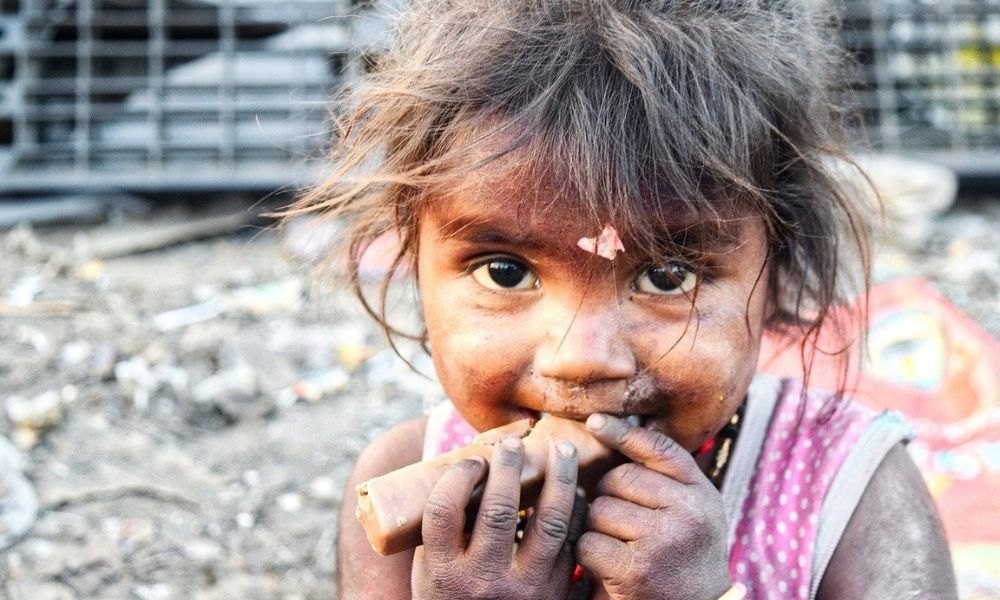
Credits: Pixabay
Hunger Eradication: A Dream Yet To Meet Reality
India, 6 July 2021 1:48 PM GMT
Editor : Ankita Singh |
A literature lover who likes delving deeper into a wide range of societal issues and expresses her opinions about the same. Keeps looking for best-read recommendations while enjoying her coffee and tea.
Creatives : Ratika Rana
Her primary objective is to inform, promote, educate and cultivate readers through writing.
According to a report by the United Nations, 40% of the total produce in India is either lost or wasted.
In India, 20 per cent of children under the age of five years are underweight, and 38 per cent have stunted growth.
The inefficient management of food available has led to starvation even though there is no scarcity of food in India. According to a report by the United Nations, 40% of the total produce is either lost or wasted. India ranks amongst the highest pedestals when it comes to malnutrition, as more than 200 million of our population has insufficient access to food.
India houses one-fourth of the world's hungry population. The Global Hunger Index (GHI) ranked India 94th out of 107 countries. The country fares poorly and has been battling widespread hunger for decades together. The GHI is calculated based on four indicators:
- The fraction of under-nourished in a set of population
- The fraction of children under the age of five enduring from wasting (Children who have less weight in proportion to the height they possess)
- The fraction of children under five bearing stunting (Unusually low height in comparison to their age)
- The mortality rate of children under the age of five.
These four parameters determine the GHI score on a hundred point scale.
Contributing Factors
Poverty is one of the most critical factors that contribute to the prevailing hunger crisis in India. The shocking fact remains that two-thirds of the people living in India are poverty-stricken.
A total of 68.8 per cent of people survive on less than $2 per day. The lack of employment that could provide a sustainable wage in rural India pushes many to migrate from their native villages to metropolitan cities like Mumbai, Delhi and Bangalore.
The decision of ration cards to the poor was a game-changer when it came to reducing poverty. The Public Distribution System (PDS) was undisputedly a novel idea. However, the administering authorities lacked in implementation.
Scores of people were unable to access the ration because they were unaware of the government's policies. Reports of PDS shops being shut, corruption scandals in PDS and low quality of food items being distributed made news on several occasions.
Unequal income distribution and the rising inflation will ultimately make a particular section of society unable to buy certain food items. If there lies discrimination in employment, it is inevitable to avoid the subsequent income divide in the country. In the globally rising prices of commodities scenario, it is highly unlikely that people belonging to the upper and upper-middle sections of the society will have to struggle for food on their plates because they do not spend most of their incomes on food. However, 80 per cent of the income of poor people is spent on securing two square meals in a day.
One of the most concerning factors that fuel the current hunger crisis in India is the amount of food that goes waste. As reported by Times Now, 67 million tonnes of food is wasted annually in India, which costs around ₹ 92,000 crore. This amount is sufficient to feed the entire population of Bihar for one year. The amount of wheat that rots every year in India is equal to the annual wheat production in Australia.
Collaboration with World Food Programme (WFP)
The United Nation's World Food Programme is the largest humanitarian exercise focused on eradicating hunger and providing food security to the needy and the poor. Assisting more than 97 million people in 88 different countries worldwide, the organisation has a vision of saving lives and changing lives. The WFP won Nobel Prize for all the successful humanitarian aid that it provides to poverty-stricken countries.
The organisation has been working with India since 1963. It has provided aid to ensure food distribution and providing technical assistance to the Asian country since it achieved self-sufficiency in cereal production.
From ensuring the proper functioning of the public distribution system that serves around 800 million poor people in India to identify India's most food-insecure areas and ensure policy and relief work, the WFP is striving hard towards achieving zero hunger.
The WFP even came forward with a strategic plan to promote access to food by improving nutrition whilst monitoring and evaluating the schemes and policies set up by the government of India to eradicate hunger and help the needy.
As per a report by Down To Earth, during the GHI 2019 report, India's food stock was more than 68 million tonnes (excluding unmilled paddy) stored in different warehouses under the Food Corporation of India (FCI). Until September 2020, the same food stock reached 70 million tonnes (excluding unmilled paddy). Regardless of excess food in stock, the government is unable to ensure that nobody slept hungrily.
How can we improve the situation?
India needs a practical multi-dimensional approach to win over the food crisis. The Union Government must ensure that small and marginal farmers can grow more crops in a year. This would augment the annual supply of food grains.
Apart from this, ensuring the supply of raw foodgrains is an insufficient provision. Government-sponsored canteens that can provide cooked meals to the poorer section of the society at nominal prices like ₹ 20-25 per plate would be helpful, especially in difficult times such as the COVID induced lockdown. Also, more schemes for rural employment should be started so as to increase employment opportunities in villages and small towns as well.
The 'One Nation, One Ration Card' standpoint of the government should be implemented to reach the lowest strata of uneducated, unaware and unemployed citizens. A road map of operations and backup strategies should be kept handy to ensure that individuals seeking foodgrains and government support are helped.
The food crisis of 2008 had led several developing countries to face food riots. Whether or not will we be able to avert the country's food crisis hangs in front of the political parties in power.
Experts firmly believe that if we continue to tread the same route, we would have more victims due to the unequal distribution of food. A check on the trade practices of private traders is imperative. In a populous country like India, making policies is just the tip of the iceberg. The main focus should be on the implementation of those policies which will likely improve the country's situation.
Also Read: Karnataka Allocates Rs 26,000 Crore For Development Of SC, ST
 All section
All section














